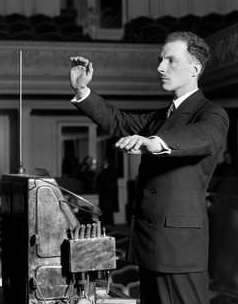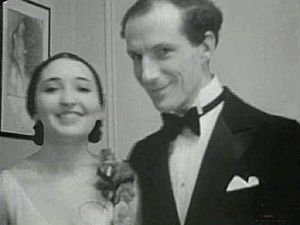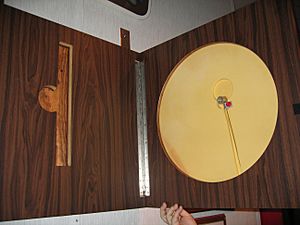Leon Theremin facts for kids
Quick facts for kids
Leon Theremin
|
|
|---|---|

Lev Termen demonstrating the theremin, December 1927
|
|
| Born |
Lev Sergeyevich Termen
27 August [O.S. 15 August] 1896 Saint Petersburg, Russian Empire
|
| Died | 3 November 1993 (aged 97) Moscow, Russia
|
| Occupation | Engineer, Physicist |
| Known for | Theremin, The Thing |
Lev Sergeyevich Termen (who later became known as Leon Theremin) was a Russian inventor. He was born on August 27, 1896, and passed away on November 3, 1993. He is most famous for inventing the theremin. This was one of the very first electronic musical instruments ever made. It was also the first electronic instrument to be produced in large numbers.
Leon Theremin also worked on early television technology. He created a special listening device called "The Thing". This device was hidden for seven years in the Moscow office of the United States Ambassador. It allowed Soviet agents to secretly listen to important conversations.
Contents
Early Life and Discoveries
Leon Theremin was born in Saint Petersburg, which was then part of the Russian Empire, in 1896. His father, Sergei Emilievich Theremin, had French roots. His mother, Yevgenia Antonova Orzhinskaya, was of German background. He also had a sister named Helena.
When he was in high school, he showed off different light effects using electricity to an audience. By the age of 17, he had his own lab at home. There, he experimented with high-frequency circuits, light, and magnetic fields.
His cousin, Kirill Fedorovich Nesturkh, was a young physicist. He invited Leon to a special presentation by Abram Fedorovich Ioffe. Leon learned about Ioffe's work on the electron. He found Ioffe's explanations about electrons and magnetic fields very interesting. They helped him see the world in a new, scientific way. From then on, Leon wanted to study the tiny parts of the world, just like he had studied the vast universe with his homemade telescope.
Leon remembered building a huge Tesla coil in school. He noticed a bright glow when he tried to make the air glow. He wanted to study this more using university equipment. A meeting with Abram Ioffe led him to Karl Karlovich Baumgart, who managed the physics lab. Karl gave Leon a room and equipment for his experiments. Abram Ioffe also suggested Leon look into how gases glow under different conditions. However, Leon was called to serve in World War I before he could finish these studies.
Military Service and War Times
Even though he was only in his second year of university, Leon was sent to the Nikolayevska Military Engineering School in Petrograd (which was Saint Petersburg then). This school usually only accepted older students. Abram Ioffe told him the war would not last long. He also said that military experience would be useful for science.
Leon started his military service in 1916. He finished the Military Engineering School in just six months. He then got a diploma as a military radio-engineer that same year. Over the next three and a half years, he did many important things. He helped build a radio station in Saratov to connect the Volga area with Moscow. He also graduated from Petrograd University. He became a leader at a new Military Radiotechnical Laboratory in Moscow. Finally, he became the broadcast supervisor for a radio transmitter near Petrograd.
During the Russian Civil War, in October 1919, a commander named Nikolai Nikolayevich Yudenich tried to capture the radio station near Petrograd. Leon and others moved the equipment to safety. Leon then blew up the tall antenna mast so it couldn't be used by the enemy. He then went to Petrograd to set up a new listening station. He also trained radio specialists there.
One evening, when Leon was feeling down, Abram Ioffe called him. Ioffe asked Leon to come to his new Physical Technical Institute in Petrograd. The next day, he invited Leon to start working on new ways to measure high-frequency electrical signals.
Working with Ioffe and the Theremin
Leon started working at the institute right away. He worked on many different projects. He used hypnosis to help people read measurements more accurately. He also worked with Ivan Pavlov's laboratory. He built a high-frequency device to measure gases very precisely. Ioffe encouraged him to find other uses for this method. Soon, Leon created the first motion detector. This was used as a "radio watchman".
While working on this device, Leon added circuits to make an audio tone. He noticed that the sound's pitch changed when he moved his hand near it. In October 1920, he showed this to Ioffe. Ioffe called in other professors and students to hear it. Leon tried to play tunes he remembered from playing the cello, like "The Swan". By November 1920, Leon gave his first public concert with the instrument. He had changed it so that a horizontal antenna controlled the volume. He called it the etherphone. In the Soviet Union, it was known as the Termenvox. In the USA, it became known as the theremin.
In 1925, Leon went to Germany. He sold the patents for his radio watchman and the Termenvox to a German company. He also worked on a wireless television during this time. In 1925, his television had 16 lines. By 1926, it improved to 32 and then 64 lines. On June 7, 1927, he showed blurry, moving images. His device was the first working television in Russia.
Life in the United States
Leon Theremin went on a long tour of Europe starting in 1927. He showed his invention to large crowds in London, Paris, and Germany. He then traveled to the United States, arriving on December 30, 1927. In 1928, he played the theremin with the New York Philharmonic orchestra. He patented his invention in the United States in 1928. He then allowed RCA to produce the theremin for sale.
In the 1930s, Leon set up a laboratory in New York. There, he made the theremin even better. He also experimented with other inventions and new electronic musical instruments. One of these was the Rhythmicon. This instrument was requested by the Russian composer Joseph Schillinger.
In 1930, ten theremin players performed together at Carnegie Hall. Two years later, Leon led the first-ever electronic orchestra. It featured the theremin and other electronic instruments. This included a "fingerboard" theremin that looked like a cello. Leon himself was a cellist.
In 1931, he worked with composer Joseph Schillinger to build the rhythmicon. Leon's mentors during this time included important scientists and musicians. These included composer Joseph Schillinger and physicist Albert Einstein.
Leon worked closely with Clara Rockmore, who was also a talented theremin player from the Soviet Union. Leon asked her to marry him several times. However, she chose to marry attorney Robert Rockmore instead.
The U.S. Federal Bureau of Prisons hired Leon. They wanted him to build a metal detector for Alcatraz Federal Penitentiary. Leon was also interested in using the theremin for dance music. He created special places where sounds and lights would change based on dancers' movements.
While in the U.S., Leon married Lavinia Williams. She was a young African-American ballerina. Their marriage was a surprise to many people around him.
Return to the Soviet Union
Leon Theremin suddenly went back to the Soviet Union in 1938. At the time, no one was sure why he returned. Some thought he missed his home country. Others believed Soviet officials had taken him. His wife, Lavinia, said he had been "kidnapped from his studio" by some Russians.
Years later, it was found that Leon had returned because of money problems in the United States. However, Leon himself once said he left because he was worried about the upcoming war. Soon after he returned, he was put in Butyrka prison. Later, he was sent to work in the Kolyma gold mines. Even though many thought he had been executed, Leon was actually sent to work in a sharashka. This was a secret laboratory within the Gulag camp system. He worked there with other famous scientists like Andrei Tupolev and Sergei Korolev. The Soviet Union officially cleared his name in 1956.
Espionage Work
While working at the sharashka, Leon Theremin was in charge of other workers. He created the Buran eavesdropping system. This system was an early version of a laser microphone. It used a weak infrared light beam from a distance to detect sound vibrations in glass windows. Lavrentiy Beria, the head of the secret police (NKVD, which later became the KGB), used the Buran device to spy on foreign embassies in Moscow. In 1947, Leon Theremin received the Stalin prize for inventing this important spying technology.
Leon also invented another listening device called The Thing. It was hidden inside a wooden replica of the Great Seal of the United States. In 1945, Soviet schoolchildren gave this hidden bug to the U.S. Ambassador. It was presented as a "gesture of friendship" to the USSR's World War II ally. The device hung in the ambassador’s office in Moscow. It secretly listened to conversations for seven years during the early Cold War, until it was found by accident in 1952.
Later Life and Legacy
After being released from the sharashka in 1947, Leon Theremin continued to work with the KGB until 1966. By 1947, he had married his third wife, Maria Gushina. They had two children, Lena and Natalia.
Leon worked at the Moscow Conservatory of Music for 10 years. He taught there and built theremins, electronic cellos, and some terpsitones. The terpsitone was another of his inventions. A music critic from The New York Times, Harold Schonberg, discovered him there. But when an article about Leon appeared, the Conservatory's director said that "electricity is not good for music." He had Leon's instruments removed and banned electronic music projects. Leon was then fired.
In the 1970s, Leon Theremin was a Physics Professor at Moscow State University. He continued to develop his inventions and guide students.
After 51 years in the Soviet Union, Leon Theremin began to travel again. He visited France in 1989 and the United States in 1991. His daughter Natalia went with him each time. In New York, he met Clara Rockmore again. He also gave a concert in the Netherlands in early 1993. Leon Theremin passed away in Moscow on November 3, 1993, at the age of 97.
Family
- Katia (Ekaterina Pavlovna) Konstantinova, first wife
- Lavinia Williams, second wife (no children)
- Maria Gushina, third wife
- Elena "Lena" Theremin - daughter
- Natalia Theremin - daughter
- Maria "Masha" Alekseyevna Theremin - granddaughter
- Olga Theremin - granddaughter
- Peter Theremin - great-grandson
Media and Books
- The documentary film Theremin: An Electronic Odyssey was released in 1993.
- His life story and his Great Seal bug invention were shown in a 2012 episode of Dark Matters: Twisted But True.
- In 2000, Theremin: Ether Music and Espionage by Albert Glinsky was published.
- In 2014, Canadian writer Sean Michaels published the novel Us Conductors. It was inspired by the relationship between Leon Theremin and Clara Rockmore.
- In 2022, French writer Emmanuel Villin published the novel La Fugue Thérémine, which tells Leon Theremin's life story.
Key Inventions
- Theremin (1920) - An electronic musical instrument played without touching it.
- Burglar alarm, or "Signalling Apparatus" (1920s) - Used the theremin effect to detect movement.
- Electromechanical television (around 1925) - An early television system.
- Terpsitone (1932) - A platform that turned dance movements into sounds.
- Theremin cello (around 1930) - An electronic cello without strings or a bow.
- Keyboard theremin (around 1930) - A small keyboard that made horn-like sounds.
- Rhythmicon (1931) - The world's first drum machine.
- The Buran eavesdropping device (1947 or earlier) - Used an infrared beam to listen through windows.
- The Great Seal bug (1945 or earlier) - A hidden listening device, considered an early form of RFID technology.
Images for kids
See also
 In Spanish: León Teremin para niños
In Spanish: León Teremin para niños
- Spharophon, a Theremin-like instrument made by Jörg Mager around 1921
- Lee de Forest, inventor of the amplifying vacuum tube
- The Trautonium, an early electronic instrument contemporary with the theremin invented by Friedrich Trautwein and later developed by Oskar Sala
- Maurice Martenot, inventor of the Ondes Martenot, a keyboard-based instrument using the heterodyning method
- Robert Moog
- Raymond Scott






